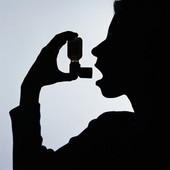WEDNESDAY, Jan. 12 (HealthDay News) — Just over 8 percent of Americans have asthma, according to the latest estimates from the U.S. Centers for Disease Control and Prevention.
 Even higher rates found among women, kids, minorities.
Even higher rates found among women, kids, minorities.
That finding is gleaned from an overall portrait of current asthma trends, as outlined in a National Center for Health Statistics 2011 report entitled “Asthma Prevalence, Health Care Use, and Mortality: United States, 2005-2009.”
A study team led by Dr. Lara J. Akinbami, from the Office of Analysis and Epidemiology at the National Center for Health Statistics, which is part of the CDC, composed their current asthma snapshot with data obtained from the National Health Interview Survey, the National Ambulatory Medical Care Survey, the National Hospital Ambulatory Medical Care Survey, the National Hospital Discharge Survey, and the National Vital Statistics System.
Crunching the numbers, the authors found that 24.6 million Americans (or 8.2 percent) have asthma.
However, the percentage of people with asthma was found to be higher than the national average among specific groups, including women, children, non-Hispanic blacks and Puerto Ricans.
People living below the poverty line, as well as residents of both the Northeast and the Midwest, were also found to have higher-than-average rates of asthma.
The authors noted that, in 2007, emergency rooms across the United States saw 1.75 million asthma-related visits and 456,000 asthma-related hospitalizations.
By 2008, asthma patients were missing 14.2 million days of work each year, as well as 10.5 million school days, the report stated.
Dr. Jonathan Field, director of the allergy and asthma clinic at New York University School of Medicine/Bellevue Medical Center in New York City, cautioned that the reported trends might reflect a medical community reporting bias.
“The issue is that people living in poorer communities are more likely to get care for their asthma in emergency rooms and academic centers, whereas wealthier individuals often get seen in a private practice setting, which don’t always report their figures as readily,” he explained.
“But unfortunately there are also a lot of things in poorer communities and inner cities, where you see larger minority populations, that make asthma more of an issue,” Field acknowledged. “Some of the trends could have a genetic component. But socioeconomics certainly plays a role as, for example, regards access to care and the ability or inability to afford medicines. So there are certainly a lot of things at work here.”
More information
For more on asthma prevalence, visit the U.S. Centers for Disease Control and Prevention.
SOURCES: National Center for Health Statistics, news release, Jan. 12, 2011; Jonathan Field, M.D., director, allergy and asthma clinic, New York University School of Medicine/Bellevue Medical Center, New York City
Copyright © 2011 HealthDay. All rights reserved.
![]()
